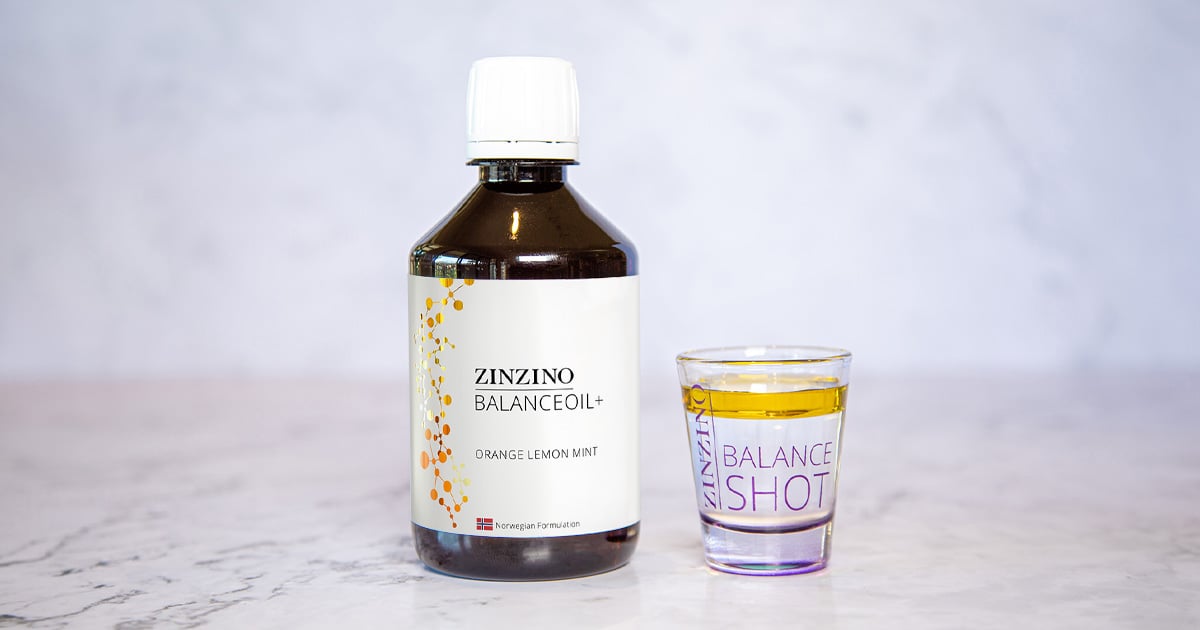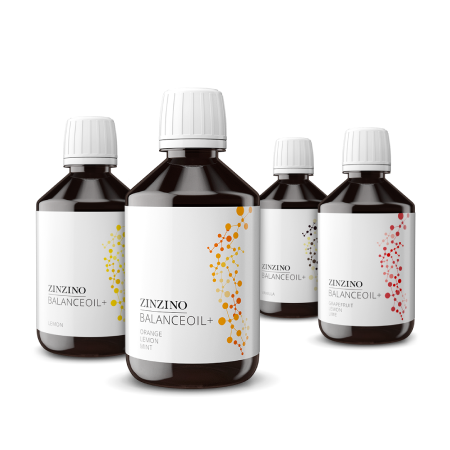How to take your Omega supplement

With the incredible health benefits from Omega-3, it’s important to be strategic about your intake. From supporting normal brain1 and heart function2, to maintaining healthy vision3 and blood pressure4, upping your Omega-3 is one of the best tools in your health arsenal.
Fish and other natural Omega-3 sources should be your first option to capture these benefits. However, it might be difficult to gain the appropriate amount of this essential nutrient through food alone and you might need to support your nutrition by taking supplements.
BalanceOil+ is Zinzino’s hero in its test-based personalized nutrition strategy. The Polyphenol Omega Balance food supplement, high in olive polyphenols and Vitamin D3. A pure, non-GMO blend of oils derived from wild-caught small fish and pre-harvest, extra virgin olive oil, it supports normal immunity5, protection against oxidative stress6, as well as healthy blood calcium levels7, bones8, muscle function9, teeth10, and cell division11.
Use BalanceOil+ to improve your health with natural, science-based nutrition products that are customized to your body. Empower your health by using fish oil in your daily routine. As it is a liquid food supplement, there are endless ways to take your BalanceOil+.
15+ EFSA-approved health benefits, without the fishy taste
Gift your body 2,500 mg of Omega-3 (of which 1,300 mg EPA, 700 mg DHA and150 mg DPA) and 700 mg of Omega-7 for every 12ml serving… Here are five of the most popular ways to balance your body from within, without compromising on flavor.
On its own
Get your nutrients in on an empty stomach as soon as you wake up. Just pour your dose into a glass and take it, while the coffee machine is heating up. It feels good knowing you’re starting the day having already done something good for your health.
As a #BalanceShot
Prefer to get your food supplements out of the way, first thing in the morning? Put your bottle of BalanceOil+ right next to the coffee machine so you don’t forget. While you’re preparing your first cup, pull out the shot glass and take your daily dose – 1/3 BalanceOil+ and 2/3 water or juice for the perfect #BalanceShot
In an Omega-3 smoothie recipe
If smoothies are your breakfast preference, add your BalanceOil+ dose as one of your ingredients. When it comes to vitamins for smoothies, the options are endless. BalanceOil+ perfectly complements any fruity or nutty concoction you whip up.
The Zinzino community loves to use turmeric, kale, spinach, blueberries, strawberries, Greek yogurt, lemon, cucumber, banana, orange, ginger, cayenne, chia, flaxseeds, avocado, beetroot, apple, oats, cacao, mint, and carrot. Put your bottle of BalanceOil+ with your smoothie ingredients. This is the easiest way to pack all these nutrients in, as well as the 15+ BalanceOil+ health benefits.
With water, juice or kombucha
Start your day with a glass of lemon water, juice, kombucha or just water (and AquaX or BalanceOil+). AquaX is in the BalanceOil+ family of products but differs with its AquaCelle® ingredient – a self-micro-emulsifying delivery system – which dissolves in water. Enjoy better texture, taste and absorption compared to other Omega-3 products. Pour your specific BalanceOil+ dose, mix it with your favourite drink. You’ll forget there’s fish oil in it.
In softgels
Sometimes, it’s more convenient to group all your food supplements together. Take Essent+, the softgel version of BalanceOil+. The naturally sourced ingredients even extend to the casing, as the capsules are made from fish gelatin. There are a couple of standout ingredients in Essent+ compared to the liquid supplement – cacao powder and pure anchovies, a triglyceride concentrate that contains 85% EPA and DHA.
You’ll likely create your own ways to consume BalanceOil+ or Essent+, but this list is a good place to start. Take the guesswork out of healthier living. Decide when you’d prefer taking your fish oil, morning or afternoon, then pick your ingredients to make it a fun part of your daily routine. Find your balance and stick to it.
* These statements have not been evaluated by the Food and Drug Administration. This product is not intended to diagnose, treat, cure, or prevent any disease.
1. DHA contributes to the maintenance of normal brain
DHA trägt zur Erhaltung einer normalen Hirnfunktion bei. Die Angabe darf nur für Lebensmittel verwendet werden, die mindestens 40 mg DHA pro 100 g und pro 100 kcal enthalten. Um gesundheitsbezogene Angaben machen zu können, muss der Verbraucher die Information erhalten, dass sich die positive Wirkung bei einer Tagesdosis von 250 mg EPA und DHA einstellt. Die Aufnahme von Docosahexaensäure (DHA) durch die Mutter trägt zur normalen Hirnentwicklung des Fötus und des Säuglings bei. Schwangere und stillende Frauen müssen informiert werden, dass sich die positive Wirkung bei einer Tagesdosis von 200 mg DHA zusätzlich zu der empfohlenen Tagesdosis für Omega-3-Fettsäuren für Erwachsene einstellt, d. h. 250 mg DHA und EPA. Die Angabe darf nur für Lebensmittel verwendet werden, die eine Tagesdosis von mindestens 200 mg DHA enthalten.
2. DHA and EPA contribute to the normal function of the heart
DHA und EPA tragen zu einer normalen Herzfunktion bei. Die Angabe darf nur für Lebensmittel verwendet werden, bei denen es sich zumindest um eine EPA- und DHA-Quelle im Sinne der Angabe Omega-3-Fettsäure-QUELLE handelt, wie im Anhang zur Verordnung (EG) Nr. 1924/2006 aufgeführt ist. Um die gesundheitsbezogene Angabe tragen zu dürfen, muss der Verbraucher die Information erhalten, dass sich die positive Wirkung bei einer Tagesdosis von 250 mg EPA und DHA einstellt.
3. DHA contributes to the maintenance of normal vision
DHA trägt zur normalen Funktion der Augen bei. Die Angabe darf nur für Lebensmittel verwendet werden, die mindestens 40 mg DHA pro 100 g und pro 100 kcal enthalten. Um gesundheitsbezogene Angaben machen zu können, muss der Verbraucher die Information erhalten, dass sich die positive Wirkung bei einer Tagesdosis von 250 mg EPA und DHA einstellt. Die Aufnahme von Docosahexaensäure (DHA) trägt bei Babys bis zu 12 Monaten zur Entwicklung eines normalen Sehvermögens bei. Der Verbraucher muss die Information erhalten, dass sich die positive Wirkung bei einer Tagesdosis von 100 mg DHA einstellt. Wenn die Angabe auf Folgenahrung verwendet wird, muss das Lebensmittel mindestens 0,3 % der gesamten Fettsäuren als DHA enthalten.
4. DHA and EPA contribute to the maintenance of normal blood
DHA und EPA tragen zur Aufrechterhaltung normaler Triglyceridwerte im Blut bei. Die Angabe darf nur für Lebensmittel verwendet werden, die eine Tagesdosis von 2 g EPA und DHA enthalten. Um die gesundheitsbezogene Angabe tragen zu dürfen, muss der Verbraucher die Information erhalten, dass sich die positive Wirkung bei einer Tagesdosis von 2 g EPA und DHA einstellt. Wenn die Angabe auf Nahrungsergänzungsmitteln und/oder angereicherten Lebensmitteln verwendet wird, muss der Verbraucher die Information erhalten, dass die ergänzende Tagesdosis von 5 g EPA und DHA kombiniert nicht überschritten werden darf. DHA trägt zur Aufrechterhaltung normaler Triglyceridwerte im Blut bei. Die Angabe darf nur für Lebensmittel verwendet werden, die eine Tagesdosis von 2 g DHA liefern und die DHA in Kombination mit Eicosapentaensäure (EPA) enthalten. Um die gesundheitsbezogene Angabe tragen zu dürfen, muss der Verbraucher die Information erhalten, dass sich die positive Wirkung bei einer Tagesdosis von 2 g DHA einstellt. Wenn die Angabe auf Nahrungsergänzungsmitteln und/oder angereicherten Lebensmitteln verwendet wird, muss der Verbraucher die Information erhalten, dass die ergänzende Tagesdosis von 5 g EPA und DHA kombiniert nicht überschritten werden darf.
5. Vitamin D contributes to immune system
Vitamin D trägt zur normalen Funktion des Immunsystems bei. Die Angabe darf nur für Lebensmittel verwendet werden, bei denen es sich zumindest um eine Vitamin-D-Quelle im Sinne der Angabe Vitamin-D-QUELLE handelt, wie im Anhang zur Verordnung (EG) Nr. 1924/2006 aufgeführt ist.
6. Olive oil polyphenols
Polyphenole aus Olivenöl tragen zum Schutz der Blutfette vor oxidativem Stress bei. Der Ersatz von gesättigten Fettsäuren durch ungesättigte Fettsäuren in der Ernährung trägt zur Aufrechterhaltung eines normalen Cholesterinspiegels im Blut bei. Ölsäure ist eine ungesättigte Fettsäure. Die Angabe darf nur für Olivenöl verwendet werden, das mindestens 5 mg Hydroxytyrosol und dessen Derivate (z. B. Oleuropein-Komplex und Tyrosol) pro 20 g Olivenöl enthält. Um die gesundheitsbezogene Angabe tragen zu dürfen, muss der Verbraucher die Information erhalten, dass sich die positive Wirkung bei einer Tagesdosis von 20 g Olivenöl einstellt.
7. Vitamin D calcium levels
Vitamin D trägt zu einem normalen Kalziumspiegel im Blut bei. Die Angabe darf nur für Lebensmittel verwendet werden, bei denen es sich zumindest um eine Vitamin-D-Quelle im Sinne der Angabe VITAMIN-D-QUELLE handelt, wie im Anhang zur Verordnung (EG) Nr. 1924/2006 aufgeführt ist.
9. Vitamin D normal muscle function
Vitamin D trägt zur Erhaltung einer normalen Muskelfunktion bei. Die Angabe darf nur für Lebensmittel verwendet werden, bei denen es sich zumindest um eine Vitamin-D-Quelle im Sinne der Angabe VITAMIN-D-QUELLE handelt, wie im Anhang zur Verordnung (EG) Nr. 1924/2006 aufgeführt ist.
11. Vitamin D cell division
Vitamin D spielt eine wichtige Rolle bei der Zellteilung. Die Angabe darf nur für Lebensmittel verwendet werden, bei denen es sich zumindest um eine Vitamin-D-Quelle im Sinne der Angabe VITAMIN-D-QUELLE handelt, wie im Anhang zur Verordnung (EG) Nr. 1924/2006 aufgeführt ist.




Share this page
Or copy link